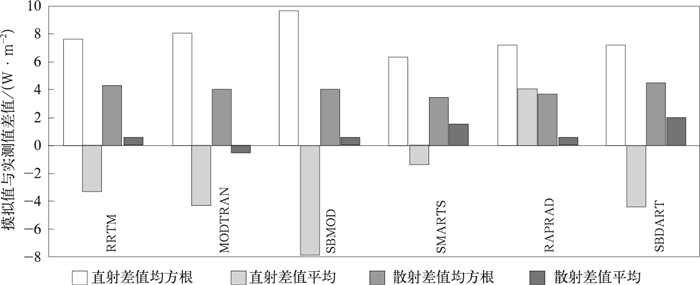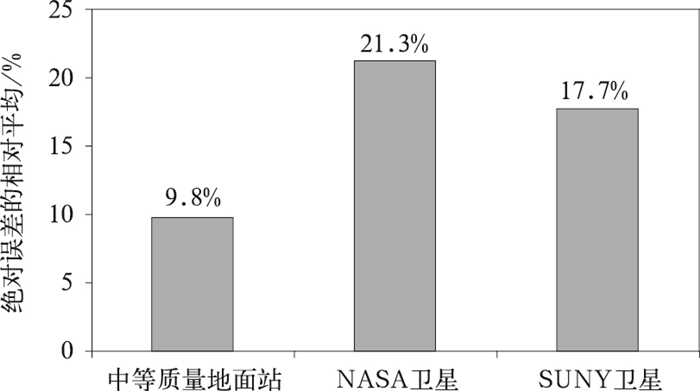Reconsideration About Effects of Natural Environmental Conditions on the Calculation of Solar Energy Resources in China
-
摘要: 文章简单回顾了以前国内常用的太阳辐射资源的计算方法,评论了各自存在的主要问题。其中最重要的是我国大地势以及其他自然条件影响下的基础辐射问题。在以前的研究中虽也注意到了这一问题,但解决得既不理想,也不彻底。关键是这些解决方法依靠的仅仅是辐射实测站点的天文辐射数据。由于测站有限,直接影响到对不同经度、纬度、地势、气候等自然条件下的基础数据的推算。该文利用SMARTS模式依据每个气象站的平均气压、绝对湿度、能见度等数据推算出符合当地环境条件的晴天辐射数据,作为基础辐射数据,进而达到考虑各地真实大气条件来计算晴天辐射的目的。Abstract:
In the calculation of solar energy resources, Ångström method, by means of the sunshine percentage is most commonly used. But it should be noted that this method is suitable for regions where the natural environment is relatively homogeneous. Such conditions are easy to get to meet for small countries or regions. However, for the large countries, e.g., China, it is inappropriate to make an assumption that the natural environment is homogeneous. On one hand, the impact of the terrain on radiation can't be ignored; on the other hand, other atmospheric factors that affect the radiation incident, such as the layer of atmospheric water content, content of aerosol particles and so on, also can't be ignored. Former Soviet Union is also a vast country, and its scholars exclude regions where the altitude is higher than 1500 m when they are dealing with the terrain effect. This approach doesn't resolve the radiation distribution in the mountain area, but from a scientific perspective, it is prudent and rigorous.In the previous researches, the selection of the basic radiation, such as extraterrestrial radiation, clear radiation has been paid more attentions to. This is very important for the Ångström method; however, it doesn't consider the former facts influencing solar radiation enough.The clear radiation close to the actual conditions is calculated based on SMARTS model from Gueymard. In SMARTS model, each factor influencing solar radiation is considered, such as the whole layer water content deduced by surface water content, the aerosol effect considered by horizontal visibility, and the ozone effect derived by ozone content distribution. The clear radiation calculated in this way can be used as basic radiation, which helps overcome the lack of previous work ignoring the atmospheric impact factor. Owing to lack of observation data, the clear radiation in the whole country is not calculated. Only the clear radiation at Chengdu Station and Emei Mount Station are calculated. With the previous method, the results are much the same for two stations, but with the new method, the differences are quite obvious.
-
Key words:
- solar resource calculation;
- SMARTS model;
- clear radiation
-
表 1 SMARTS程序所必需输入的计算参数
Table 1 The necessary input parameters for SMARTS model
月份 成都站 峨眉山站 臭氧
/DU能见度
/km整层水汽
/cm地面气温
/℃地面气压
/hPa臭氧
/DU能见度
/km整层水汽
/cm地面气温
/℃地面气压
/hPa1 270 6.45 1.33 5.6 964.0 277 32.83 0.01 -5.7 699.4 2 272 8.46 1.49 7.5 961.5 278 26.49 0.01 -5.0 698.6 3 284 10.08 1.91 11.5 958.3 289 26.19 0.01 -1.3 699.6 4 293 12.12 2.58 16.7 954.9 298 22.34 0.01 2.9 701.4 5 288 12.72 3.38 21.0 952.3 290 21.92 0.02 6.3 702.8 6 285 12.72 4.41 23.7 948.6 287 20.78 0.04 9.3 702.5 7 279 12.13 5.18 25.2 946.5 280 18.87 0.04 11.6 702.7 8 278 12.39 4.95 25.0 949.0 279 18.56 0.04 11.2 704.5 9 273 11.46 4.13 21.2 955.5 274 19.08 0.03 7.7 706.0 10 263 10.07 3.05 17.0 961.0 261 18.91 0.02 3.5 706.2 11 265 8.03 2.09 12.1 963.9 261 31.69 0.01 -3.0 704.6 12 267 6.11 1.50 7.2 965.5 261 39.08 0.01 -3.5 702.1 表 2 成都站、峨眉山站晴天辐射和天文辐射计算结果 (单位:MJ/m2)
Table 2 The calculated clear solar radiation and extraterrestrial solar radiation at Chengdu Station and Emei Mount Station (unit: MJ/m2)
时段 成都站 峨眉山站 天文辐射 地面辐射 天文辐射 地面辐射 1月 653.1 325.3 652.6 526.4 2月 721.5 399.1 721.1 590.8 3月 981.6 575.9 981.2 824.0 4月 1106.1 673.0 1105.8 934.6 5月 1242.8 753.4 1242.5 1046.6 6月 1237.7 740.5 1237.3 1019.8 7月 1256.9 765.6 1256.6 1043.0 8月 1175.8 711.1 1175.5 970.0 9月 1004.3 597.4 1004.0 829.5 10月 860.0 491.7 859.6 706.3 11月 670.8 349.9 670.4 554.3 12月 608.4 292.2 607.9 494.6 全年 11519.0 6675.1 11514.5 9539.9 -
[1] Кандратьев К Я Лучистая энергия солца. 太阳辐射能. 李怀瑾, 译. 北京: 科学出版社, 1962. [2] 翁笃鸣.中国辐射气候.北京:气象出版社, 1997. [3] 高国栋, 陆渝蓉.中国地表面辐射平衡与热量平衡.北京:科学出版社, 1982. [4] 张运林, 秦伯强, 陈伟民, 等.太湖无锡地区太阳总辐射的气候学计算及特征分析.应用气象学报, 2003, 14(3):339-347. http://qikan.camscma.cn/jams/ch/reader/view_abstract.aspx?file_no=20030341&flag=1 [5] 杨羡敏, 曾燕, 邱新法, 等. 1960—2000年黄河流域太阳总辐射气候变化规律研究.应用气象学报, 2005, 16(2):243-248. doi: 10.11898/1001-7313.20050230 [6] 中华人民共和国气候图集.北京:气象出版社, 2002. [7] Барашкова Е П и др. Радиационный рецим территории СССР. Гидрометиздат, 1961. [8] 王炳忠, 张富国, 李立贤.我国的太阳能资源及其计算.太阳能学报, 1980, 1(1): 1-9. http://www.cnki.com.cn/Article/CJFDTOTAL-TYLX198001001.htm [9] 祝昌汉.再论总辐射计算方法 (二).南京气象学院学报, 1982, 2(2): 196-206. http://www.cnki.com.cn/Article/CJFDTOTAL-NJQX198202005.htm [10] 傅抱璞.论坡地上的太阳辐射总量.南京大学学报:自然科学, 1958(2):47-82. http://www.cnki.com.cn/Article/CJFDTOTAL-NJDZ195802002.htm [11] 傅抱璞.实际地形中辐射平衡各分量的计算.气象学报, 1964, 34(1):62-73. doi: 10.11676/qxxb1964.007 [12] 李占清, 翁笃鸣.一个计算山地地形参数的计算机模式.地理学报, 1987, 42(3):269-278. http://www.cnki.com.cn/Article/CJFDTOTAL-DLXB198703008.htm [13] 李占清, 翁笃鸣.坡面散射辐射的分布特征及其计算模式.气象学报, 1988, 46(3):349-356. doi: 10.11676/qxxb1988.043 [14] 王开存, 周秀骥, 刘晶淼.复杂地形对计算地表太阳短波辐射的影响.大气科学, 2004, 28(4): 625-633. http://www.cnki.com.cn/Article/CJFDTOTAL-DQXK200404013.htm [15] 曾燕, 邱新法, 刘昌明, 等.基于DEM的黄河流域天文辐射空间分布.地理学报, 2003, 58(6): 810-816. doi: 10.11821/xb200306002 [16] 曾燕, 邱新法, 刘昌明, 等.起伏地形下黄河流域太阳直接辐射分布式模拟.地理学报, 2005, 60(4): 680-688. doi: 10.11821/xb200504017 [17] 李梦洁, 郑建飞, 曾燕, 等.浙江省高分辨率太阳直接辐射图的计算和绘制.地球科学进展, 2008, 23(3):299-305. http://www.cnki.com.cn/Article/CJFDTOTAL-DXJZ200803011.htm [18] 姜创业, 王娟敏, 孙娴, 等.陕西省山地太阳总辐射分布式模拟研究.地理与地理信息科学, 2010, 26(3):91-94. http://www.cnki.com.cn/Article/CJFDTOTAL-DLGT201003022.htm [19] 袁淑杰, 缪启龙, 谷晓平, 等.贵州高原起伏地形下太阳直接辐射的精细分布.自然资源学报, 2009, 24(8):1432-1439. doi: 10.11849/zrzyxb.2009.08.012 [20] 武永利, 张洪涛, 田国珍, 等.复杂地形下山西高原太阳潜在总辐射时空分布特征.气象, 2009, 35(5):74-82. doi: 10.7519/j.issn.1000-0526.2009.05.011 [21] 左大康, 王勃贤, 陈建绥.中国地区太阳总辐射的时空分布特征.气象学报, 1963, 33(1):78-96. doi: 10.11676/qxxb1963.007 [22] 钟强.青藏高原太阳总辐射的计算方法讨论.高原气象, 1986, 5(3):197-210. http://www.cnki.com.cn/Article/CJFDTOTAL-GYQX198603000.htm [23] 孙治安, 高庆先, 史兵, 等.中国可能太阳总辐射的气候计算及其分布特征.太阳能学报, 1988, 9(1):12-23. http://www.cnki.com.cn/Article/CJFDTOTAL-TYLX198801002.htm [24] 翁笃鸣, 高歌.晴天太阳总辐射的一种参数化形式.南京气象学院院报, 1995, 18(3):317-323. http://www.cnki.com.cn/Article/CJFDTOTAL-NJQX503.000.htm [25] Gueymard C. SMARTS, A Simple Model of the Atmospheric Precipitable Water and Transfer of Sunshine: Algorithms and Performance Assessment. Professional Paper FSEC-PF-270-95. Florida Solar Energy Center. [26] Michalsky J J. Shortwave radiation closure studies for clear skies during the atmospheric radiation measurement 2003 aerosol intensive observation period. J Geophys Res, 2006, 111, D14S90. doi: 10.1029/2005JD006341/suppinfo [27] 王炳忠, 申彦波.使用太阳能光谱应用模式——SMARTS模式.北京:气象出版社, 2011. [28] [2011-08-02]. http://ozoneaq.gfsc.nasa.gov/OMIOzone.md. [29] 孙治安.我国平均水汽含量含量的气候计算及其时空分布特征.南京气象学院院报, 1987, 10(1):74-80. http://www.cnki.com.cn/Article/CJFDTOTAL-NJQX198701008.htm [30] 王炳忠, 刘庚山.我国大陆大气水汽含量的计算.地理学报, 1993, 48(3):244-253. http://www.cnki.com.cn/Article/CJFDTOTAL-DLXB199303005.htm [31] 杨景梅, 邱金桓.我国可降水量同地面水汽压关系的经验表达式.大气科学, 1996, 20(5):620-626. http://www.cnki.com.cn/Article/CJFDTOTAL-DQXK605.013.htm [32] 杨景梅, 邱金桓.用地面湿度参数计算我国整层大气可降水量及有效水汽含量方法的研究.大气科学, 2002, 26(1):9-22. http://www.cnki.com.cn/Article/CJFDTOTAL-DQXK200201001.htm [33] Muhammad Iqbal.An Introduction to Solar Radiation. New York: Academic Press, 1983. [34] Gueymard C. Analysis of monthly average atmospheric precipitable water and turbidity in Canada and Northern United States. Solar Energy, 1994, 53(1):57-71. doi: 10.1016/S0038-092X(94)90606-8 [35] 和清华, 谢云.我国太阳总辐射气候学计算方法研究.自然资源学报, 2010, 25(2): 308-319. doi: 10.11849/zrzyxb.2010.02.015 [36] 中华人民共和国气象行业标准QX/T89-2008.太阳能资源评估方法.北京:气象出版社, 2008. [37] 王炳忠, 申彦波.从资源角度对太阳能装置最佳倾角的讨论.太阳能, 2010(7):17-20. http://www.cnki.com.cn/Article/CJFDTOTAL-TYNZ201007009.htm [38] Hall James, Hall Jeffrey. Quality Analysis of Global Horizontal Irradiance Data from 3500 US Ground-based Weather Stations. [2011-08-02]. http://www.solardatawarehouse.com/data.aspx#Technical_Papers/. -


 设为首页
设为首页 加入收藏
加入收藏



 下载:
下载:


